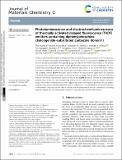Files in this item
Photoluminescence and electrochemiluminescence of thermally activated delayed fluorescence (TADF) emitters containing diphenylphosphine chalcogenide-substituted carbazole donors
Item metadata
| dc.contributor.author | Kumar, Shiv | |
| dc.contributor.author | Tourneur, Pauline | |
| dc.contributor.author | Adsetts, Jonathan R. | |
| dc.contributor.author | Wong, Michael Y. | |
| dc.contributor.author | Rajamalli, Pachaiyappan | |
| dc.contributor.author | Chen, Dongyang | |
| dc.contributor.author | Lazzaroni, Roberto | |
| dc.contributor.author | Viville, Pascal | |
| dc.contributor.author | Cordes, David B. | |
| dc.contributor.author | Slawin, Alexandra M. Z. | |
| dc.contributor.author | Olivier, Yoann | |
| dc.contributor.author | Cornil, Jérôme | |
| dc.contributor.author | Ding, Zhifeng | |
| dc.contributor.author | Zysman-Colman, Eli | |
| dc.date.accessioned | 2022-03-08T17:30:15Z | |
| dc.date.available | 2022-03-08T17:30:15Z | |
| dc.date.issued | 2022-03-28 | |
| dc.identifier | 278181766 | |
| dc.identifier | 9ef1576d-dc42-4ab7-92e3-ca490b9bcdd8 | |
| dc.identifier | 000758357400001 | |
| dc.identifier | 85128127377 | |
| dc.identifier.citation | Kumar , S , Tourneur , P , Adsetts , J R , Wong , M Y , Rajamalli , P , Chen , D , Lazzaroni , R , Viville , P , Cordes , D B , Slawin , A M Z , Olivier , Y , Cornil , J , Ding , Z & Zysman-Colman , E 2022 , ' Photoluminescence and electrochemiluminescence of thermally activated delayed fluorescence (TADF) emitters containing diphenylphosphine chalcogenide-substituted carbazole donors ' , Journal of Materials Chemistry C , vol. 10 , no. 12 , pp. 4646-4667 . https://doi.org/10.1039/d1tc05696d | en |
| dc.identifier.issn | 2050-7526 | |
| dc.identifier.other | Jisc: 125046 | |
| dc.identifier.other | ORCID: /0000-0002-9527-6418/work/109766393 | |
| dc.identifier.other | ORCID: /0000-0002-5366-9168/work/109766472 | |
| dc.identifier.other | ORCID: /0000-0001-7183-6022/work/109766688 | |
| dc.identifier.other | ORCID: /0000-0001-8079-0425/work/109766767 | |
| dc.identifier.uri | https://hdl.handle.net/10023/25013 | |
| dc.description | SK acknowledges the financial support from European Union's Horizon 2020 research and innovation programme under Marie Skłodowska Curie Individual Fellowship (MCIF; Agreement No. 748430-THF-OLED). P. R acknowledges support from a Marie Skłodowska-Curie Individual Fellowship (No. 749557). The work has been supported in Mons by European Union through the Interreg V initiative France-Wallonie-Vlaanderen project LUMINOPTEX and the Belgian National Fund for Scientific Research (FRS-FNRS). Computational resources were provided by the Consortium des Équipements de Calcul Intensif (CÉCI) funded by F. R. S.-FNRS under Grant 2.5020.11. J. C. is an FNRS research director. Y. O. acknowledges funding by the Fonds de la Recherche Scientifique-FNRS under Grant no F.4534.21 (MIS-IMAGINE). We acknowledge the research support from Natural Sciences and Engineering Research Council Canada (NSERC, DG RGPIN-2013-201697, DG RGPIN-2018-06556, and SPG STPGP-2016-493924), Canada Foundation of Innovation, Ontario Innovation Trust (CFI/OIT, 9040) and Western University. J. R. A. appreciates the Ontario graduate scholarships (2018–2022). EZ-C is a Royal Society Leverhulme Trust Senior Research fellow (SRF\R1\201089). | en |
| dc.description.abstract | Aiming to develop efficient blue-emitting thermally activated delayed fluorescence (TADF) compounds, we have designed and synthesized derivatives of the well-known sky-blue emitter 2CzPN that contain electron-accepting phosphine chalcogenide groups to stabilize the HOMO level relative to the pristine compound, thus increasing the HOMO–LUMO gap and blue-shifting the emission wavelength. By cyclic voltammetry, photophysical data and quantum-chemical calculations, it was found that polar solvents and matrices validated the proposed concept, but these trends were not recovered in non-polar media. The suitability of these 2CzPN derivatives in polar matrices for optoelectronic applications was explored with electrochemiluminescence (ECL) by measuring emission delays, radical stability, emission stabilities, emission efficiencies and emission spectra. Some of the 2CzPN derivatives showed an unprecedented delayed onset of the ECL, and delayed rising time to the ECL maximum, as well as long ECL emission decay. All of these mentioned delay times suggest that these luminophores primarily emit via organic long-persistent electrochemiluminescence (OLECL) mechanisms. The derivatization of the donor groups of the emitters affected both the radical stability and the predominant emission mechanism, providing important insight into their potential as emitters in solid-state electroluminescent devices. | |
| dc.format.extent | 22 | |
| dc.format.extent | 5728256 | |
| dc.language.iso | eng | |
| dc.relation.ispartof | Journal of Materials Chemistry C | en |
| dc.subject | QD Chemistry | en |
| dc.subject | DAS | en |
| dc.subject | AC | en |
| dc.subject | MCC | en |
| dc.subject.lcc | QD | en |
| dc.title | Photoluminescence and electrochemiluminescence of thermally activated delayed fluorescence (TADF) emitters containing diphenylphosphine chalcogenide-substituted carbazole donors | en |
| dc.type | Journal article | en |
| dc.contributor.sponsor | European Commission | en |
| dc.contributor.sponsor | European Commission | en |
| dc.contributor.sponsor | The Royal Society | en |
| dc.contributor.institution | University of St Andrews. EaSTCHEM | en |
| dc.contributor.institution | University of St Andrews. School of Chemistry | en |
| dc.contributor.institution | University of St Andrews. Centre for Energy Ethics | en |
| dc.identifier.doi | 10.1039/d1tc05696d | |
| dc.description.status | Peer reviewed | en |
| dc.identifier.url | https://doi.org/10.26434/chemrxiv-2021-2270g | en |
| dc.identifier.grantnumber | 748430 | en |
| dc.identifier.grantnumber | 749557 | en |
| dc.identifier.grantnumber | SRF\R1\201089 | en |
This item appears in the following Collection(s)
Items in the St Andrews Research Repository are protected by copyright, with all rights reserved, unless otherwise indicated.

